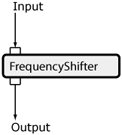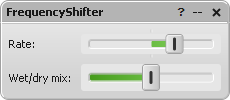| AudioMulch Help > Contraption Reference > Effects | Previous Next |
FrequencyShifter
Shifts harmonics to create metallic sounds, or sweeping phaser-like effects when used with subtle settings and feedback.

FrequencyShifter shifts all frequencies in the input signal up or down by the amount specified by the Rate parameter. Frequency shifting is not the same as pitch shifting; pitch shifting maintains the harmonic relationship between all frequencies, while frequency shifting shifts all frequencies by the same amount. When used subtly (for example, at a rate of less than 10Hz), FrequencyShifter can stretch or compress the harmonic series of a sound. At rates higher than this an effect similar to ring modulation is created. You can also control the ratio of the input signal to the frequency shifted signal (wet/dry mix). If you use a low rate and a 50% wet/dry mix, you can create a whooshing sound similar to a Phaser or Flanger. You can then use the Rate parameter to control the speed of the whooshing.
 |
See the Adjusting Contraption Properties section for information about using sliders, knobs, presets etc. |
Related Contraptions
Parameters

Rate (ShiftFrequency) |
Specifies the amount by which frequencies are shifted, with a range of +/-20000 Hz. When the Wet/dry mix parameter is set to around 50%, the Rate parameter determines the speed at which the whooshing sound sweeps. |
Wet/dry mix (WetDryMix) |
Controls the ratio of input vs. frequency-shifted signal. |
Relevant Example Files
The following files provide examples of how FrequencyShifter can be used:
FrequencyShifterHarmonicFeedback.amh, TranceRiffer.amh & ResonantString.amh
 |
To open the Example Files directory, go to the File menu, select Open, and double-click on the Examples folder. Read descriptions of the example files here. |
Suggested Uses and Practical Applications
Andrew Bencina says: “By combining both the wet and dry signals (using a Wet/Dry mix of 50% for example) and using a small amount of frequency shifting (less than +/-5Hz for example), an upwards or downwards phasing effect can be created which is somewhat like that created by the Phaser and the Flanger. This technique works best with broadband sounds (those with a broad range of frequencies).”
| Previous Next |
